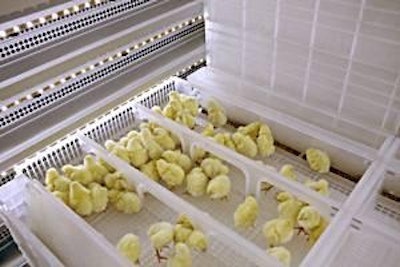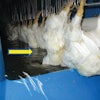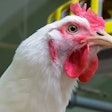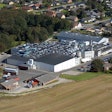
Faced with restraints on erection of new housing in Western Europe, manufacturers are advocating innovative broiler growing systems that offer reductions in labor and enhanced efficiency.
Amongst technologies under discussion at the event, two systems, the HatchBrood from HatchTech and the Patio from Vencomatic, could be said to represent “out of the box” thinking, while the more traditional Big Dutchman AviMax and Farmer Automatic multi-tier growing modules are refinements of existing technology.
HatchBrood
The HatchBrood concept from HatchTech is a logical extension of the research and technology devoted to the design of single-stage setters and hatchers. The system is, in effect, a “post-hatcher”, designed to provide chicks with an optimal environment, sufficient floor space and access to feed and water to optimize growth and maturity over the first four days of the brooding period.
After hatching and chick processing, the day-old batches are placed in a HatchBrood unit with a capacity of almost 40,000 chicks. Air temperature, air velocity, humidity and carbon dioxide levels are controlled, as in a conventional hatcher. Chicks are placed in plastic Cradles providing 80 cm2 for each of the 50 chicks. Water and feed are supplied from troughs located on each side of the Cradle. HatchBrood units are divided into 12 sections, each with temperatures sensors.
The HatchBrood controller adjusts temperature which can be either heated or cooled to conform to a predetermined set point. Fans achieve uniform laminar airflow of 0.3 m/second. Fresh air enters the HatchBrood through inlet nozzles in the ceiling of the unit. The volume of incoming air is controlled by static pressure, carbon dioxide level, humidity and temperature. The HatchBrood unit is illuminated using LED lamps which are energy efficient and allow dimming and dark periods contributing to optimal welfare and growth.
At four days of age, chicks are transported to broiler grower farms for the remaining period of development. In a presentation at the VIV EGGS! Program, sponsored by WATT, Conny Maatjens, affiliated with both HatchTech and Wageningen Agriculture Institute, presented data on body weight, uniformity and chick length at 96 hours of age.
All of these parameters numerically exceeded the values obtained from control chicks transferred from a conventional hatcher to a broiler house with litter. There were no figures presented regarding live weight for age, livability and feed conversion efficiency at depletion which would be required to evaluate the financial benefit of the system. Claimed advantages include slightly lower 38 day mortality (3.5% vs 4.2% for controls) and improved flock uniformity. An apparent advantage of the systems is that approximately one complete cycle can be obtained each year by integrating the HatchBrood module into placement and depletion, assuming a 38-40 day growing period.
Patio
Vencomatic has adopted a unique approach to brooding and broiler grow out. The Patio system comprises a multi-tier growing module that can be installed as a retro fit in existing broiler houses or as a new installation.
Using the Patio system, after 18 days of incubation at the hatchery, eggs at setter trays eggs are transferred from the hatchery to the broiler growing unit. The trays containing the fertile egg are placed on racks on the top of each tier of the growing module. Chicks hatch in the trays and drop to the surface of the module that has a thin layer of litter where they dry and start eating and drinking, similar to chicks placed in conventional houses. The growing modules can be supplied in 4 to 6 tier units fitted with manure belts. Compatible heating, ventilation and lighting installation are installed in the house.
Vencomatic claims more “robust” chicks from the Patio system, since chicks are provided with an optimal environment with respect to ventilation and heating and have immediate access to feed and water after hatch.
Results of 42 trials were presented by Lotte van de Ven. From over 1.2 million eggs placed, hatchability from the Patio system attained 96.2% (of fertile eggs) compared to 94.5% hatch-to-fertile from controls. The age of parent flocks supplying eggs ranged from 29 to 50 weeks. Average 7-day mortality in the Patio system was approximately 1%, with a range of 0.9 for old parent flocks to 1.6% for the youngest flock. The average improvement in day-old chick weight over 13 cycles was approximately 5.8 grams or 13.4% higher than comparable chicks subjected to conventional hatching.
Over the 42 comparisons, chicks reared in the Patio system attained 70-90 grams more weight at processing than control chicks hatched under conventional management and transferred to the Patio system after 21 days of incubation. The claimed advantage of 2.8 times more efficient land use and optimizing the cube volume of a house is not unique to the Patio system and would be common to any multi-tier growing unit. Vencomatic claims 1.5% higher hatchability and a 50% decrease in energy during the early brooding period with enhanced growth and livability.
Multi-tier broiler growing systems
Big Dutchman demonstrated the AviMax multi-tier modular broiler growing system. The principal advantage for the unit comprises the flexible plastic mesh floor which offers a trampoline effect, contributing to skeletal integrity and development of leg and wing muscles. The floor is self-cleaning, reducing footpad lesions (pododermatitis) and breast blisters. The floor pivots at the time of depletion transferring mature broilers to the end of the row on the manure belt where they can be transferred to coupes or transport modules with minimal labor and handling.
Depending on the design, a four-row installation in a single house can supply a plant operating at 10,000 broilers per hour. Stocking density in the modules is related to final weight with each 1.5m x 2.4m section with a continuum extending from 120 broilers at a final weight of 1.5 kg or 60 broilers attaining 3.0 kg.
Projections of capital cost show an advantage for multi-tier broiler systems in comparison with conventional litter-floor houses. The benefits are even greater in countries where housing costs are exceptionally high, where there is a shortage of wood shavings or other substrate for litter and where installation of highly efficient ventilation and cooling systems can overcome the effects of high temperature and solar heat load.
Farmer Automatic also demonstrated its broiler module, which is similar to the Big Dutchman AviMax. Their systems are supplied in up to three tiers and are supplied with Farmer Automatic chain feeding, nipple drinkers and a plastic mesh floor. The floor can be folded at the time of depletion allowing broilers to be transported to the end of the row on the polypropylene manure belt.
Although the multi-tier broiler growing systems were developed to allow increased utilization of available housing in Western Europe, these innovative approaches also have application in export markets. HatchTech has delivered units into Eastern Europe and Australia. Vencomatic has sold Patio systems to clients in Russia. Big Dutchman and Farmer Automatic are actively pursuing opportunities in the Middle East where conditions favor multi-tier grow out.
Commercial success will depend on attaining the performance suggested by initial limited-scale field trials of both the Patio and HatchBrood systems. Retrofitting houses with AviMax or Farmer Automatic conventional multi-tier modules may represent a more prudent approach since the durability and efficiency of these units has been proven.
It is, however, necessary to ensure that ventilation systems, emergency power supply and biosecurity are commensurate with the needs of flocks held at high density. Management training is required to ensure competence in interacting with the computerized control systems and observing flocks for any deviation from normal health or performance.



















